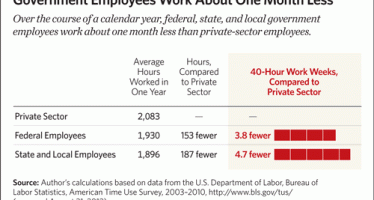Change in accounting rule forces governments to disclose liabilities
 State and local governments will no longer be allowed to hide the true costs of the long-term benefits provided to government workers.
State and local governments will no longer be allowed to hide the true costs of the long-term benefits provided to government workers.
A recent change by the Governmental Accounting Standards Board, known simply by the acronym GASB, forces government bodies to be more transparent in reporting pension liabilities and long-term commitments for retiree heath care. Among the changes: the liabilities must be reported on the first page of financial reports instead of being buried in a footnote.
“Applying accounting standards can sometimes be complex, but identifying the right standards to apply should be straightforward,” GASB Chairman David A. Vaudt said of a slew of accounting changes.
While changes in accounting rules may not garner time on the evening news, accounting rules have been the primary method for forcing governments to address the rising cost of unfunded pension and health care liabilities. In 2007, the board began implementation of GASB 45, a change in accounting rules that, for the first time, forced government bodies to disclose their pension liabilities. That change was enough to put the issue of pension liabilities on the mainstream public radar.
California’s next major liability: Other Post-Employment Benefits
Although governments have been slow to address the problem of unfunded pension liabilities, the government accounting board nonetheless raised the profile of the issue. With its most recent changes, GASB is likely to drive a conversation about “other post-employment benefits.” Health care benefits are the biggest and most common post-employment perk, which can also include life insurance, disability coverage, legal assistance and other services.
From an accounting perspective, it’s easier to budget for pension liabilities than other post-employment benefits. Due to court rulings, governments have little authority to reduce or change promised pensions. That makes it a liability with a present-day obligation.
In contrast, other post-employment benefits do not have the same legal protections as pensions. As Bloomberg noted earlier this year, “The Supreme Court unanimously decided that retiree health benefits are not necessarily guaranteed.” That case involved private sector workers. In theory, the Court’s ruling could also extend to the public sector.
“Consequently, some governments may be able to change the benefits or employees’ eligibility to receive benefits, or even stop providing benefits altogether, whenever they wish,” GASB explains in a newly published fact sheet. “These facts raise questions about whether OPEB is a liability that should be reported in the financial statements.”
Although the new accounting standards force governments to disclose the liabilities, it does not require governments to set aside funds or budget for the future. “How a government actually pays for OPEB is a policy decision made by government officials,” the board explains.
“These newly published OPEB standards will give financial statement users a much more complete picture of how much state and local governments have promised in retiree benefits—and how much those promises actually cost,” Vaudt, who serves as chairman of the government accounting standards board, said in a press release. “Together with the Board’s recent pension standards, these standards will provide consistent and comprehensive guidance for the full suite of postemployment benefits that governments provide to their employees.”
Rising cost of unfunded health care liabilities
Ed Mendel, who covers the state’s pension issues at CalPensions.com, points out that the rising unfunded liabilities arising from promised retiree health care benefits is skyrocketing. Since 2007, the retiree health care liability for state workers has increased by $24.2 billion. Retiree health care benefits provided to state workers now exceeds $72 billion – more than the state’s unfunded pension liability.
“State worker retiree health care has been one of the fastest-growing state expenses: $1.9 billion next fiscal year, up fourfold from $458 million in 2001,” notes Mendel, one of the state’s top journalists covering pensions. “It’s also one of the most generous benefits, requiring no contribution from most state workers.”

Governor Jerry Brown
This year, Governor Jerry Brown raised the issue of retiree health care benefits with his January budget proposal. As Mendel notes, the governor is looking to move the state away from “pay-as-you-go” funding in favor of pre-funding future health care benefits. By paying in advance, governments are able to reap the benefits of investing the funds and earning more money through appreciation and interest.
“If we don’t rein things in, then down the road there will be drastic cuts, just like there were over the last 10 years,” Brown said earlier this year. “It’s either stop and start or steady as you go.”
The governor’s proposal could be a double-edged sword for the state’s long-term budget picture. By negotiating changes to retiree health care benefits, some analysts believe it increases the chances that courts will protect the benefit as an irrevocable contractual obligation.
Related Articles
CA Lifeline program cost could triple under AB 1407
It’s been trendy for a couple of years now for people to dump their phone landlines and go only
Teachers want LAUSD to ignore state law, 2012 ruling
The United Teachers Los Angeles held a large rally Thursday showing strong rank-and-file support for the union’s demands that the
BART strike would provide needed clarity on compensation, union power
If I was an advisor to Gov. Jerry Brown, I’d recommend he let the BART strike play out without government




